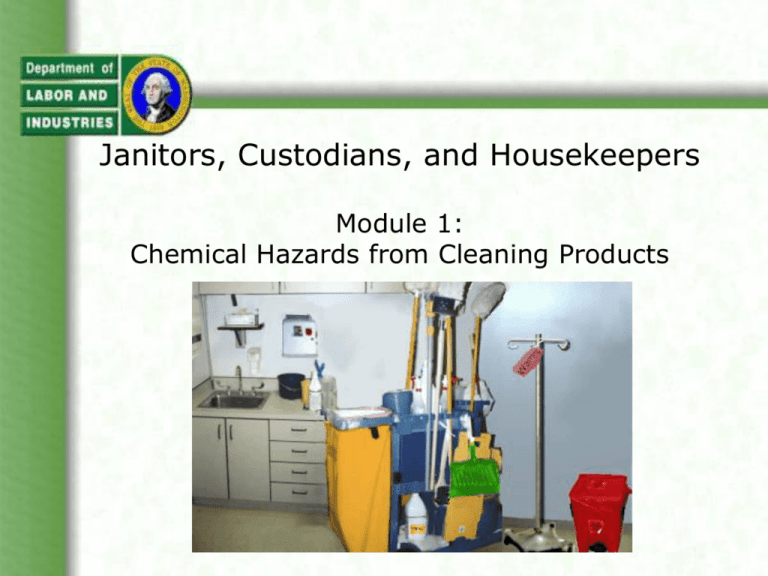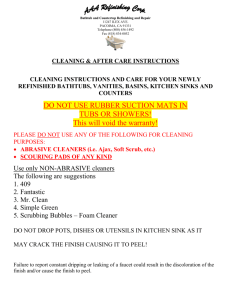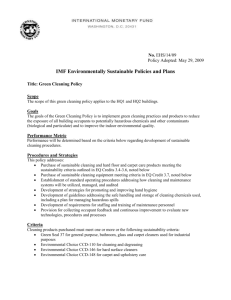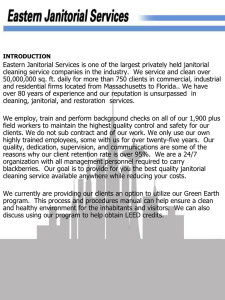Chemical Hazards
advertisement

Janitors, Custodians, and Housekeepers Module 1: Chemical Hazards from Cleaning Products This module: • Will demonstrate that janitors, custodians, and housekeepers may complete many different tasks • Is one in a series of modules that will discuss hazards janitors, custodians, and housekeepers may encounter • Will cover chemical hazards from cleaning products and provide tips for prevention – Module 2 will cover physical hazards – Module 3 will cover exposure to biological hazards – Module 4 will cover musculoskeletal hazards – Module 5 will cover removing graffiti – A stand alone module entitled “Working Alone in Safety” may also be of interest • Provide sources of additional information Janitors may have a variety of tasks: • • • • • • • • • • • Vacuuming Sweeping and Mopping Waxing floors Cleaning bathrooms Dusting furniture Moving furniture Emptying trash Restocking supplies Wiping counters Scrubbing Unstopping drains/ repairing faucets • Mowing lawns • • • • • • • • • • • • Removing stains Heating/Air conditioning Ventilation Insect control Maintaining and cleaning doors and windows Delivery/Pick up of items Extra security Weather emergencies Lab spills Helping with disabled cars Minor repairs Painting and carpentry Janitors work in a variety of buildings: • • • • • • • Hospitals Schools Universities Laboratories Factories Offices Restaurants • Stores • Nursing Homes • Clinics Most Commonly Reported Lost Time Injuries to Janitors and Custodians All other 12% Breathing chemical fumes 12% Eye irritation or burns 40% Skin irritation or burns 36% Lost time injuries are those that are so serious, the worker is off work for three days or more. Chemical hazards that may cause injuries and illness to janitors: • Cleaning, rinsing, and sanitizing agents • Hydrochloric acid • Dusts • Soot particles • Aerosols when cleaning • Solvents • Asbestos The highest risk janitorial products – Are corrosive to the eyes and skin; – Are flammable; – Give off toxic fumes; or – Are poisonous What cleaners have the most risk? Product Type How These Can Harm You Acid Toilet Bowl Cleaner with Hydrochloric acid or Phosphoric acid (Good at removing hard water rings.) Corrosive to the eyes and skin. Can cause blindness in seconds. If possible, switch to one with citric acid. Metal Cleaner With Perchloroethylene Poisonous, Causes cancer, or Flammable Carpet Spotter With Perchloroethylene Poisonous, Causes cancer, or Flammable What cleaners have the most risk? Product Type How These Can Harm You General Purpose Cleaner With Butoxyethanol, Sodium hydroxide, & Ethanolamine Butoxyethanol absorbs through your skin and can harm your blood, liver, and kidneys. Corrosive to eyes and skin, Poisonous, or Flammable Floor Finish Stripper or Baseboard Stripper With Butoxyethanol, Sodium hydroxide, & Ethanolamine Corrosive to eyes and skin, Poisonous What cleaners have the most risk? Product Type How These Can Harm You Oven Cleaner or Heavy Duty Degreaser With Sodium Hydroxide Oven cleaner in a spray can that is very convenient but can also be very dangerous. Sodium hydroxide can blind you, and the vapors can harm your lungs. Use it with care. Wear gloves & goggles and get lots of fresh air. Graffiti Remover With Butoxyethanol Poisonous, Causes cancer, or Flammable What cleaners have the most risk? Product Type How These Can Harm You Glass Cleaner With Butoxyethanol Flammable or Poisonous Disinfectant With Bleach, Phenol, Quats., or Hydrogen Peroxide Corrosive to eyes and skin & Poisonous With all cleaners: • Read the Label – Avoid products with the words “Danger”, “Poison”, or “Warning” – When you must use a strong product to get the job done, protect yourself by wearing gloves & goggles, and be sure your work area has plenty of fresh air. With all cleaners: • Call Customer Service – Most labels have an “800” number to call with questions. – Ask the customer service people to tell you if the product you are using has ingredients that may harm you. – If there is no phone number on the container, ask your distributor or the store where you bought the product. With all cleaners: • Read the Material Safety Data Sheet (MSDS) for the cleaner. – This sheet explains what is in the product, how these ingredients may harm you, and how to protect yourself while using it. Many companies also have MSDSs on their website. – You can also find them at MSDS Search http://www.msdssearch.com/msdssearch.htm The following slides will cover: Safe and Effective: 1. 2. 3. 4. 5. 6. 7. Toilet Cleaning Use of Floor Finish Strippers Carpet Cleaning Restroom Cleaning Glass Cleaning Metal Cleaning Disinfecting 1. Safe & Effective Toilet Cleaning • Don’t mix acids with bleach. This creates chlorine gas that can kill you. • Use a mild cleaner for daily toilet polishing. • Unless the toilets are already in good shape, clean them first and then use a separate disinfectant. Safe & Effective Toilet Cleaning • Use acid cleaners only when you have really stubborn stains to remove. • Acids corrode metal. Use acid cleaners only on porcelain toilet bowls. • Acid cleaners are very dangerous – always protect yourself by wearing gloves and goggles. (continued) For more information toilet cleaning see: http://www.wrppn.org/Janitorial /factsheets/toilet.htm 2. Safe & Effective Use of Floor Finish Strippers • Hard floor care involves one of the most dangerous chemical products that janitors use – floor finish stripper. Floor stripper ingredients and risks to users Absorbs through skin. Damages Butoxyethanol blood, liver, kidneys, developing babies. Monoethanolamine Absorbs through skin. Damages blood, liver, kidneys, developing babies. Can damage eyes and skin. Sodium hydroxide or Can cause blindness and Sodium Metasilicate severely damage skin. Safe & Effective Use of Floor Finish Strippers (continued) • Reducing floor stripper use is a good idea for safety and for saving money. • Stripping should be done only when needed and then it should be done in a safe effective manner to reduce exposure to these dangerous chemicals. • Reduce the need for floor stripping through – Prevention – Monitoring – Safe effective product use Safe & Effective Use of Floor Finish Strippers (continued) • Prevention: You can cut back on the need for floor stripping by keeping abrasive dirt particles from reaching the floor in the first place. – Keep dirt outdoors. Use walk-in mats at entrances. Clean mats often. – Use dust mops and vacuums to sweep up dirt frequently. – Wet mop the floor with a liquid cleaner or surface buffing product. Safe & Effective Use of Floor Finish Strippers (continued) • Monitoring: The next step for reducing stripper use is to carefully monitor the floor refinishing work that you do. – Strip floor finish only when needed. – Refinish only areas where the surface is wearing out. – Keep good records and maps to spot patterns in the way the floors are wearing – Tracking the amount of floor stripper use will often encourage people to use less. Safe & Effective Use of Floor Finish Strippers (continued) • Effective product use: – Mix the stripper with as much water as you can while still getting the job done. – Minimize mistakes, spills, and waste: • Color code equipment used for the stripper, the rinse water, and the floor finish. • Simple agitation with a machine or hand scrubber helps the stripper work more quickly and uniformly. • Use automatic dispensers for products used most frequently. • Use safe lifting techniques to avoid accidents. Safe & Effective Use of Floor Finish Strippers (continued) Reducing Worker Exposure: – Strippers are most dangerous to eyes and skin. – The concentrated product is most dangerous but the diluted product can still cause harm. Safe & Effective Use of Floor Finish Strippers (continued) Reducing Worker Exposure: •Use Goggles and Gloves •Goggles can also provide protection against irritating gases and vapors. •Some are vented to prevent fogging. •Use Ventilation Safe & Effective Use of Floor Finish Strippers (continued) A 15 minute full flow eye wash station must be provided in any area where corrosive chemicals such as floor strippers are used. Safe & Effective Use of Floor Finish Strippers (continued) • If a chemical is splashed in the eye, go immediately to the eyewash. • Hold or have both your eyelids held open. • Wash your eyes for at least 15 minutes. • Seek medical attention. Safe & Effective Use of Floor Finish Strippers (continued) Remember: • Permanent vision loss starts within 10 seconds after a worker splashes stripper concentrate into the eye. • Immediately flushing the eyes with water is essential to stop the damage from getting worse. • Skin burns start to develop in seconds as well. Quickly washing the burned area with water usually avoids permanent damage. • Harmful chemicals in strippers can be absorbed through skin to poison the user. For more information on floor finishing see: http://www.wrppn.org/Janitorial/factsheets/floor.htm 3. Safe & Effective Carpet Cleaning Carpet care products – Most are relatively safe to use but some do contain hazardous chemicals. Carpet Maintenance Program – The safest most effective program will: • • • • Choose and install carpet wisely Use methods to reduce dust and dirt Use proper cleaning methods Use the mildest, most effective products that are suited to the carpet Safe & Effective Carpet Cleaning (continued) Carpet Design and Installation – Choose the right carpet type and underlay for the area where it’s installed. – Don’t use carpets in places where water, chemicals, or hard-to-clean material are used. • Locker rooms • Kitchens • Copy centers – Consider how nearby surface will be cleaned and what may spill onto the carpet. Safe & Effective Carpet Cleaning (continued) Dust Prevention – Preventing soil and dust from entering a building means less frequent cleaning and less chemicals. • Place large walk-on mats at building entrances. • Clean the mats frequently • Experiment with different textures and sizes to see what works best – Properly maintain vents that exhaust outdoors. – Push airborne dust back out of doorways by operating the heating, ventilation, and air conditioning systems so that the air pressure just inside each doorway is higher than that of the outdoor air. Safe & Effective Carpet Cleaning (continued) Proper Cleaning Methods Vacuuming Half or more soil that falls onto carpets can be cleaned by: • Daily vacuuming with strong suction, tight filter, rotating brush machines. • Four back and forth strokes of the wand across the carpet in low traffic areas. • Up to ten wand strokes for high traffic areas and outside doorways. Safe & Effective Carpet Cleaning (continued) Proper Cleaning Methods-Spot Removal – React to spills and spots immediately – Use proper spill clean-up techniques • Start with clear, cold water and blotting cloths – Use carpet spot removal products only when needed • Use sparingly and wear goggles and gloves • Avoid products with hydrofluoric acid (rust remover) or tetrachloroethylene (“Type 4 spot remover”) Safe & Effective Carpet Cleaning (continued) Proper Cleaning Methods-Maintenance Cleaners – Rotary bonnet cleaners and carpet shampoos usually are fairly mild products – Be careful not to misuse or over-apply maintenance cleaners or you will need to do hot water extraction more often – Ingredients that are in maintenance cleaners pose the greatest risks through inhalation (e.g., isopropanol) or skin contact (e.g., butoxyethanol or ethanolamine) • Provide good ventilation • Wear gloves For more information on carpet cleaning, extractants, and mildewcides see: http://www.wrppn.org/Janitorial/factsheets/carpetcleaning.htm 4. Safe and Effective Restroom Cleaning • Maintain clean and sanitary restrooms by following a two-level cleaning schedule – Use mild products for regular daily cleaning – Use stronger products only for weekly deep cleaning 4. Safe and Effective Restroom Cleaning (continued) Regular daily cleaning: – Trash removal, surface cleaning, disinfection, and restocking supplies – Some products combine cleaning and disinfecting ingredients in one container. These combined products work well only on surfaces that are already relatively clean. – For dirty surfaces it is important to clean first, and then apply a separate disinfectant. To work well, this disinfectant must remain in place for at least 10 minutes. – Relatively mild products are available for daily restroom cleaning. Safe and Effective Restroom Cleaning (continued) Deep restroom cleaning: – Needs to be done weekly in most cases or daily in high traffic restrooms – Most deep cleaning can be done with your regular daily cleaners – Some deep cleaning tasks require stronger chemical products to remove stubborn deposits or stains. Examples of these: • Removing graffiti • Stained toilet bowls • Shower tile deposits For more information on restroom cleaning see: http://www.wrppn.org/Janitorial/factsheets/restroom.htm Safe and Effective Restroom Cleaning (continued) Restroom products range from mild to strong, and have many different ingredients. Some have acids and other chemicals that can harm you. Chemicals commonly found in strong restroom cleaners Use with extreme care (gloves and goggles) or avoid •Butane or isobutane (aerosol •propellants) •Diphosphonic Acid •Ethanolamines •Glycol Ethers (such as butoxyethanol) •Hydroxyacetic Acid •Phosphoric Acid •Propane •Quaternary Ammonium Chloride •Sodium Bisulfate •Sodium Carbonate •Sodium Hydroxide Avoid •Bleach (Sodium Hypochlorite) •Hydrochloric Acid •Nitrilotriacetic Acid •Nitrilotriacetate •Paradichlorobenzene •Perchloroethylene •Phenol •Tetrachloroethylene 5. Safe and Effective Glass Cleaning Routine Glass Cleaning: • Use a mild cleaner with alcohol or ammonia for daily glass maintenance • Avoid glass cleaning products that are flammable • Use products that are packaged in a trigger bottle rather than an aerosol can Disinfection: • If you need to disinfect the surface, use a product that contains Alkyl Ammonium Chloride to kill germs Safe and Effective Glass Cleaning (continued) Grease Removal • Grease, fingerprints, or oily deposits are sometime difficult to remove with your daily cleaner • Some of the stronger degreasing cleaners contain butoxyethanol or other toxic ingredients. If you use them: – Wear gloves and goggles – Apply the cleaner with a scrub pad if a rag or squeegee doesn’t work – Afterwards you may need to remove streaks from the degreaser by using your regular cleaner • Don’t use any degreasers made for auto repair work because they may contain flammable ingredients such as naphtha or hexane. For more information on glass cleaning see: http://www.wrppn.org/Janitorial/factsheets/glass.htm 6. Safe and Effective Metal Cleaning Routine Metal Cleaning: • Use a mild cleaner for daily polishing • Avoid metal cleaning products that are flammable • Use products that are packaged in a trigger bottle rather than an aerosol can Disinfection: • If you need to disinfect the surface, use a product that contains Alkyl Ammonium Chloride to kill germs Safe and Effective Metal Cleaning (continued) Grease Removal • Grease, fingerprints, or oily deposits are sometime difficult to remove with your daily cleaner. Some of the stronger degreasing cleaners contain butoxyethanol or similar ingredients. If you use them: – Wear gloves and goggles – Spray the degreaser onto your rag or brush, then wipe the metal surface – If that doesn’t work carefully spray degreaser onto the metal while holding your rag nearby to prevent overspray – Let the degreaser sit on the metal briefly, and then wipe it – Afterwards you may need to remove streaks from the degreaser by using your regular cleaner • Don’t use any degreasers made for auto repair work because they may contain flammable ingredients such as naphtha or hexane. • For more information on metal cleaning see: http://www.wrppn.org/Janitorial/factsheets/metal.htm 6. Safe and Effective Disinfecting • Thorough cleaning of sinks, toilets, doorknobs, and other hard surfaces that people frequently touch is the first and most important step in preventing the spread of disease. • Different ingredients or combinations of ingredients kill different germs so use an appropriate product for the job • Follow product mixing instructions and make only as much as you need. • Wear gloves and goggles because disinfectants can harm you. • Leave the disinfectant in place long enough for it to do its job Safe and Effective Disinfecting (continued) Potential Impacts of Different Disinfectants Ingredient How affects user How affects surfaces Quaternary Ammonium Chlorides Eye & skin burns Stains floor tile Phenols Eye & skin burns Corrodes plastic surfaces Sodium Hypochlorite (Bleach) Eye & skin burns; Vapors harmful Corrodes metal surfaces Hydrogen Peroxide Eye & skin burns; Vapors harmful Corrodes metal surfaces Alcohols Absorbs through skin; Vapors harmful Usually none Iodine Eye & skin burns Stains many surfaces For more information on disinfecting see: http://www.wrppn.org/Janitorial/factsheets/disinfectant.htm In Summary – Important Safety Tips • Use stronger chemicals sparingly and carefully to avoid harming the user or building occupants • Train workers in the processes and chemicals used • If possible, have people work in buddy teams when using stronger chemicals • Corrosive chemicals (acids or caustics) can blind you in seconds. Always wear goggles to protect your eyes. • Corrosives can also damage your skin and leave scars. Wear gloves to protect your hands. In Summary – Important Safety Tips • Some poisonous chemicals absorb through your skin. Always wear gloves when using products containing glycol ethers or ethanolamines. • Some poisonous chemicals are easily inhaled. Be sure your work area has enough ventilation. • Mixing different products together can create poisonous chemicals. Avoid mixing products, and be sure to rinse out work buckets after each use. Resources used for this overview: • Janitorial Products Pollution Prevention Project (Sponsored by the US Environmental Protection Agency (EPA), Cal/EPA Department of Toxic Substance Control, Santa Clara County Pollution Prevention Project, City of Los Angeles, City of Richmond, City of Santa Barbara, and Local Government Commission) http://www.wrppn.org/Janitorial/jp4.cfm • Janitorial Products Pollution Prevention Project: Cleaning Fact Sheets http://www.wrppn.org/Janitorial/factsheets.cfm • OSHA Hospital eTool http://www.osha.gov/SLTC/etools/hospital/housekeeping/housek eeping.html • International Labor Organization - International Hazard Datasheets on Occupation http://www.ilo.org/public/english/protection/safework/cis/produc ts/hdo/htm/cleaner.htm Additional Resources • MSDS Search http://www.msdssearch.com/msdssearch.htm • Removing Graffiti Safely http://istsocrates.berkeley.edu/~lohp/graphics/pdf/graffiti.pdf • Sample label - If a container loses its label, or if you feel that the original label does not provide all the information you want. http://www.westp2net.org/Janitorial/commentaries/labels. pdf WISHA Consultation Services Safety & Health program review and worksite evaluation • • • • • • By employer invitation only Free Confidential No citations or penalties Letter explains findings Follow-up all serious hazards For additional assistance, you can call one of our consultants. Click below for local L&I office locations: http://www.lni.wa.gov/Safety/Basics/Assistance/Consultation/consultants.asp Thank you for taking the time to learn about safety and health and how to prevent injuries and illnesses.






